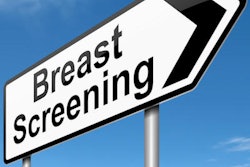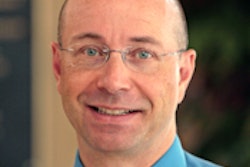When reading screening mammograms, the number of studies read per year is more important in determining the ability to detect cancer than the experience of the reader, according to a new study in the Journal of Medical Imaging that compared U.S. and Australian radiologists.
Researchers at the University of Sydney in Australia and Brigham and Women's Hospital in Boston compared the performance of Australian and U.S. radiologists, assessing whether different reading volume requirements in each country produced different accuracy rates.
Previous studies about diagnostic accuracy for mammogram reading have investigated factors such as readers' age, average annual volume of mammograms read, and the ratio of screening to diagnostic mammograms interpreted. Other possible factors include environmental characteristics such as room light, monitor cleanliness and resolution, and lesion characteristics such as calcification, mass, or architectural distortion.
The current study, however, is the first to compare radiologist performance between two countries, wrote lead author and PhD candidate Wasfi Suleiman and colleagues in the inaugural issue of the Journal of Medical Imaging, launched by SPIE, an international society for optics and photonics (JMI, April-June 2014, Vol. 1:1).
"Such a comparison may help shed light on whether differing practice requirements produce different outcomes in radiologists' accuracy," Suleiman's group wrote.
There are some differences between the Australian and U.S. breast cancer screening programs, according to the researchers.
| Breast cancer screening, Australia vs. U.S. | |||||
| Australia | U.S. | ||||
| Minimum No. of mammo read per year | 2,000 | 240 with direct supervision, then 960 every two years | |||
| Recall rate | 11% | 10% to 13.3% | |||
| Recall rate for subsequent exams | 4% | 5% to 6.6% | |||
| Age of women screened | 50 to 69 | 40 and older | |||
| Imaging | Bilateral two-projection mammography | Bilateral two-projection mammography | |||
| Cost | Free | Paid, with reimbursement from private or public insurance coverage | |||
| Breast screening policy | Double reading of screening mammograms by two screen readers independently; if the two reports do not agree, a third radiologist is included | One reading, in conjunction with computer-aided detection where available | |||
Suleiman and colleagues included 41 radiologists in the study: 21 from Australia and 20 from the U.S. The radiologists reviewed 30 mammography cases containing two-view mammograms (craniocaudal and mediolateral oblique). Twenty of the cases had abnormal findings and 10 had normal findings.
The researchers asked the radiologists to identify any malignancies and rank their confidence level on a scale of 2 to 5 (normal or benign mammograms were marked with the number 1).
The group used various measures to compare radiologist performance, calculating the jackknife free-response receiver operating characteristic (which allows quantitative analysis of observer data such as radiologist image interpretation), inferred receiver operating characteristic (ROC), area under the curve (AUC), specificity, sensitivity, and location sensitivity using specific software. To compare Australian and U.S. radiologists, the researchers used the Mann-Whitney U test.
The 41 radiologists completed a total of 1,230 readings. The Australian radiologists had a mean experience of about 16 years, lower than that of the 20 U.S. radiologists, who had a mean experience of 23 years. The Australian radiologists read an average of 11,207 cases per year, compared with an average of 6,288 cases for the U.S. radiologists.
The researchers found that when experience and the number of mammograms read per year were taken into account, the Australian radiologists showed significantly higher sensitivity.
The findings are consistent with previous research, which has shown that radiologist performance in reading mammography images correlates to the number of cases read per year rather than the number of years of experience, according to Suleiman and colleagues. Radiologists who have the highest number of cases per year perform better than those with lower numbers, and those with more years of experience do not necessarily perform better than those with fewer years.
"In fact, even though the American radiologists had the highest number of years of experience, their performance was lower in sensitivity and sensitivity when compared to the Australian sample," the team wrote.
The researchers conceded that there were limitations to the study, including a small dataset and the fact that the case set was enriched with cancer cases and therefore not typical of a screening environment. The work practices of the two groups of radiologists were also different, and the researchers did not try to correct for this.
Women deserve access to the most accurate and consistent screening, wherever they live, Suleiman and colleagues concluded.
"Women with the same disease patterns, imaged under similar conditions, should have equal opportunity for an accurate outcome, and if they do not, then investigating the reasons for any difference may help to improve breast cancer detection through mammography," they wrote.



















